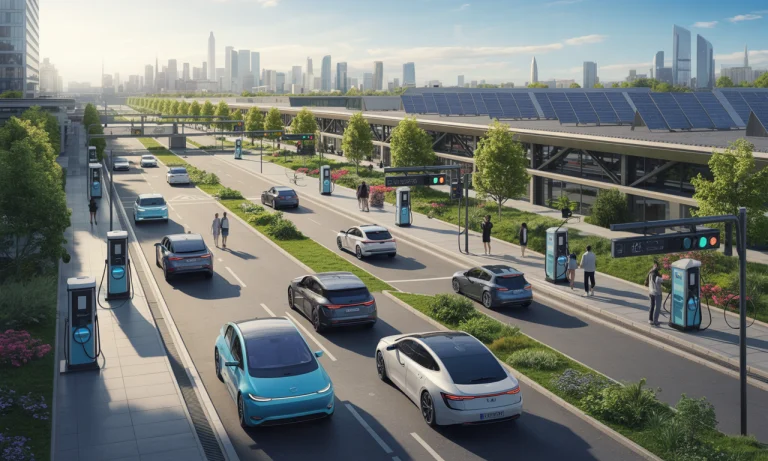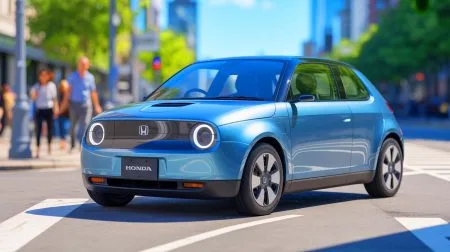In the swift rhythm of urban life, a quiet revolution is underway. Electric cars, once a rare sight at the edge of innovation, now glide through city streets, reshaping the future of commuting. Their arrival coincides with mounting concerns over pollution, the rising cost of fuel, and a growing appetite for greener, smarter mobility. As cities like Los Angeles, Oslo, and Shenzhen electrify their public transport, the narrative of daily travel is being rewritten for millions. From affordable rides to cleaner air, the effects reach far beyond technology—they’re redefining where people live, how cities plan, and what it means to move freely. This journey brings together technological titans—Tesla, Nissan, Chevrolet, BMW, Hyundai, Volkswagen, Kia, Ford, Polestar, and Rivian—driven by ambition and necessity. Exploring this transformation reveals not just a change in vehicles but a profound shift in city life, and no corner of the commute remains untouched.
Urban Air Gets Cleaner: The Environmental Impact of Electric Vehicles on City Travel
When the city of Shenzhen replaced its entire fleet with over 16,000 electric buses, the streets did more than fall silent—they became a testament to environmental change. The annual CO2 reduction, more than 1.35 million tons, cascaded into improved air quality and health. Cities embracing electric cars and buses witness a tangible drop in nitrogen oxides and particulate matter, reducing asthma and heart disease rates. This cleaner atmosphere fosters a new urban reality, where citizen well-being and public health take center stage, making the promise of sustainable city living more attainable than ever before.
| City | EV Adoption | Estimated CO2 Reduction (tons/year) |
|---|---|---|
| Shenzhen | Full electric bus fleet | 1,350,000 |
| Oslo | Majority electric buses & cars | 750,000 |
| Los Angeles | Transitioning public transport | 450,000 (projected) |
City Dwellers Notice the Change in Health
Migraines from smog-filled commutes lessen, and playgrounds once overshadowed by fumes are now lively with cleaner air. Parents in Volkswagen’s e-Golf shuttle rides or teachers using Hyundai or Kia EVs see the health ripple effects firsthand. The transformation isn’t abstract—it’s lived daily, with the benefits woven into routines. Discover more about the benefits electric cars bring in 2025’s cities.
Costs, Maintenance, and the Changing Economics of Commuting with Electric Cars
The initial sticker price may raise eyebrows—a BMW i4 or Ford Mustang Mach-E can cost more than their gas-fed ancestors. Yet, the real story unfolds over months and years. Electric vehicles slash operating costs, with owners of Tesla, Nissan Leaf, or Chevrolet Bolt saving up to 30% on fuel alone. There’s far less wear-and-tear: oil changes vanish, and regenerative braking preserves parts, cutting total maintenance by thousands over a vehicle’s lifespan (compare maintenance costs here). It’s a subtle shift that leaves more in commuters’ pockets, making mobility not just smarter, but more affordable.
| Brand | Average Annual Maintenance | Fuel/Energy Cost Savings (%) |
|---|---|---|
| Tesla | $400 | 35% |
| Hyundai | $450 | 28% |
| Chevrolet | $410 | 31% |
| Kia | $430 | 29% |
Commuting Habits and the Hidden Economics
As electricity undercuts gasoline, more commuters choose homes farther from the city center—a dynamic explored in recent urban studies. Cheaper per-mile travel means affordable housing on city margins becomes viable, but at the cost of longer commutes. This reshapes not only roads but also neighborhood demographics, inviting questions about equity and sustainability. Planners are taking notice, using agent-based models to anticipate and manage these shifts. To compare EV costs with traditional cars, see this in-depth analysis.
Electric Vehicles Quietly Revolutionize Urban Mobility and Comfort
On their first quiet morning, residents of a Polestar-equipped neighborhood shared startled smiles—gone were the diesel roars replaced by gentle hums. For passengers on electric buses, including school children and office workers, the soothing silence is more than a perk; it is transformative. Noise pollution, a longstanding urban curse, now recedes, improving sleep and reducing stress. Advances in EV range ensure that this hush extends from dawn carpools to late-night rideshares, across every major brand from Volkswagen to Rivian.
| Type of Ride | Noise Level: Combustion | Noise Level: Electric | Comfort Score (1–10) |
|---|---|---|---|
| Diesel Bus | 88 dB | — | 5 |
| EV Bus (Kia, Hyundai) | — | 58 dB | 9 |
| Traditional Car | 69 dB | — | 6 |
| Electric Car (Tesla, BMW, Nissan) | — | 53 dB | 9 |
Technology and Everyday Experience
A test drive in a Chevrolet Bolt or Ford F-150 Lightning delivers not just smooth acceleration, but an instant realization: urban life can be more peaceful. This draws people onto public transit, reduces personal car use, and gives planners new tools for designing family-friendly cities—a small step with outsize effects.
Urban Infrastructures Adapt: Charging Networks and City Planning in the Age of EVs
Policymakers now face a challenge as old as mobility itself: adapt or be left behind. The rapid rise of electric cars has pushed cities to rethink infrastructure. In downtown districts, Tesla Superchargers and Nissan/Hyundai fast-charging stations pop up next to EV-only lanes. The densest charging networks, especially near business centers, speed up adoption and influence housing choices—a finding backed by a striking study from Beijing Jiaotong University and University College London. Planners tweak zoning laws, incentivize home charging systems, and partner with firms like Volkswagen and Rivian to ensure no residential pocket becomes a charging dead zone. Discover more strategies for accelerating EV adoption through infrastructure.
| Charging Location | Avg. Walk to Office/Shop | Brands Supported |
|---|---|---|
| Public Metro Hub | 3 min | Tesla, BMW, Nissan |
| Supermarket Parking | 1 min | Kia, Chevrolet, Ford |
| Residential Complex | 0 min (home) | Hyundai, Volkswagen, Polestar |
The Next Evolution: Smart Energy Management
The reality of more EVs plugging in at once brings fresh questions about grid resilience. Smart charging systems, off-peak incentives, and vehicle-to-grid technology start to take hold, softening the impact of increased energy demand. Cities like Los Angeles and Seoul integrate renewable energy wherever possible, reinforcing the connection between EVs and sustainability. For those considering their options, guides like how to choose your first electric vehicle ease the transition.
Commuting Patterns, Urban Sprawl, and Equity: The Broader Impact of Electric Cars
As electric cars revolutionize city mobility, their unexpected side effects challenge old assumptions. With reduced running costs, people are moving farther from city centers, enticing families to seek affordable housing on the periphery. But there’s a catch: longer commutes, sometimes up to 40% more in cities with rapid EV adoption, stretch infrastructure and risk spreading congestion over wider areas. The narrative is nuanced—vehicle age and access to charging create concentric circles of affluence and disadvantage. Planners are prompted to reimagine equitable, dense developments while offering incentives that reach every corner. This dynamic, explored in depth in recent electric car overviews, demonstrates that the electrification journey is as much about policy and planning as about technology.
| Commute Distance (km) | Avg. Commute Time (min) | Primary Vehicle Type | Charging Access |
|---|---|---|---|
| 5–10 | 18 | Chevrolet, Nissan (older EVs) | High (central) |
| 15–25 | 31 | Tesla, Polestar, Volkswagen | Medium |
| 25+ | 49 | BMW, Rivian, Hyundai | Low (peripheral) |
A People’s Revolution, With Nuance
Stories emerge from all sides: a Ford driver trading suburban silence for urban convenience; a city planner reworking zoning to pull commuters back inward. These case studies echo in every metropolis positioned on the brink of electrified change. For a look at real-world range and performance, view the breakdown at battery innovations for EVs.
FAQ: Electric Cars and Urban Commuting
Does driving an electric car really save money for city commuters?
Yes, mostly through lower fuel and maintenance costs. Savings add up over time, as detailed in cost of EV ownership research, making city life more affordable for many drivers.
Are there enough public charging options for EVs in major cities?
Availability of charging stations varies, but most global cities have rapidly expanded infrastructure, with partnerships led by brands like Tesla, Volkswagen, and Hyundai. Compare networks with this charging comparison.
Do electric cars decrease urban noise pollution significantly?
Absolutely. Multiple studies show that neighborhoods with high EV adoption register much lower noise levels, improving residential quality of life.
Is urban sprawl getting worse due to cheaper EV commuting?
Evidence suggests yes—lower running costs encourage more people to live further out. Strategic urban planning and incentives can mitigate these effects, keeping commutes reasonable and cities dense.
How can someone new to EVs pick the right model for city commuting?
Consider range, maintenance, charging access, and incentives. Tools like this beginner’s guide walk you through the top choices for every urban need.
Did you like it? 4.3/5 (21)







